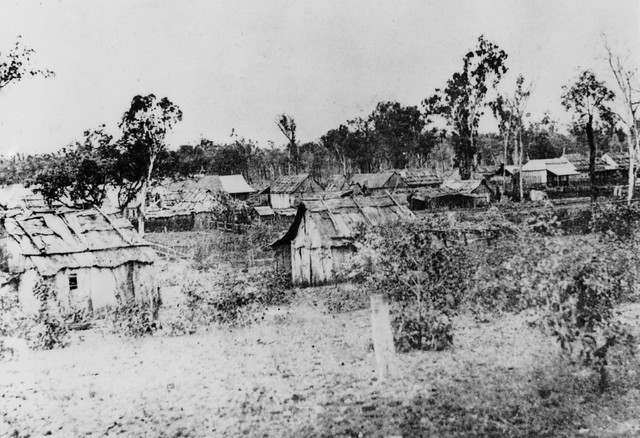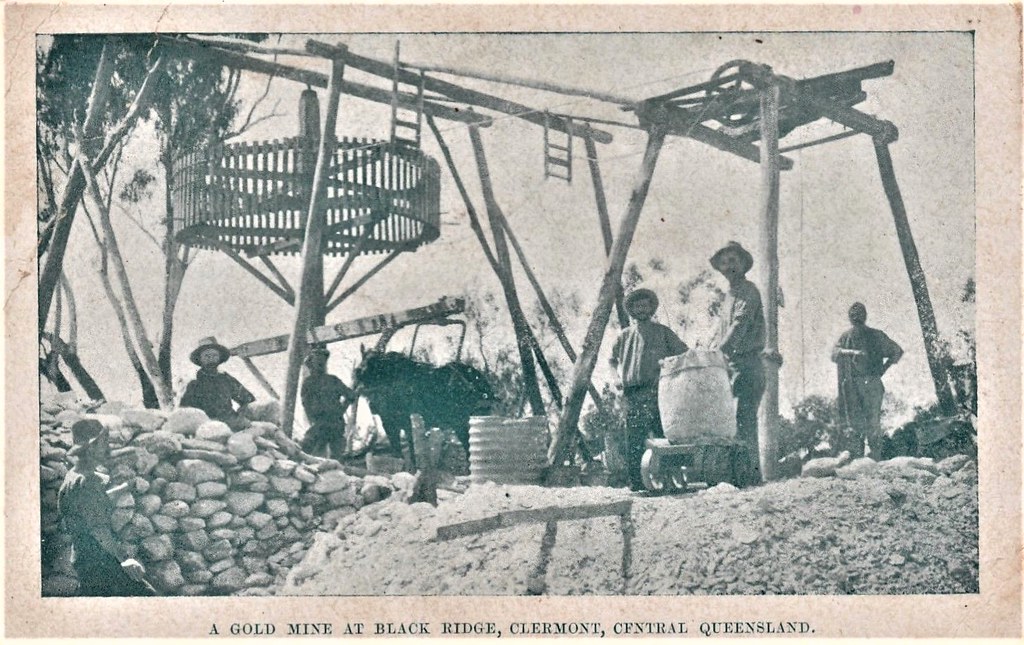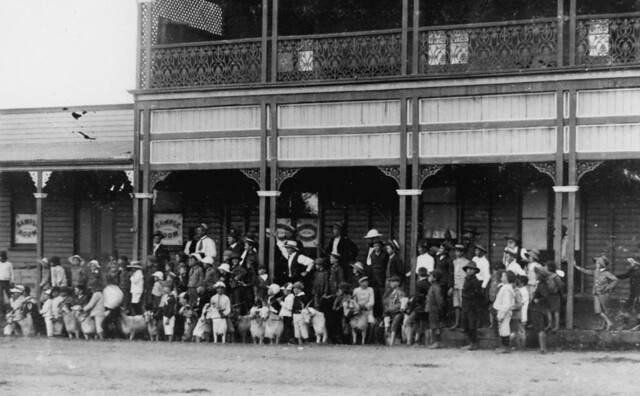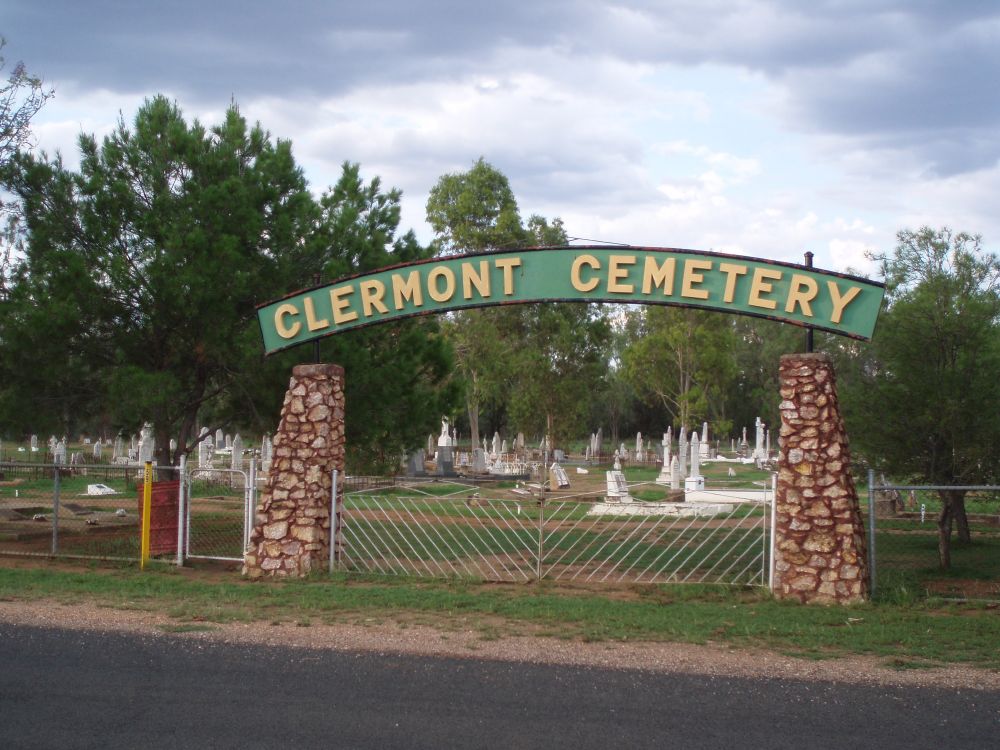Clermont is located 760 km north of Brisbane, in Queensland, Australia, not far from Peak Range National Park.
The Wangan Aboriginal People
The Wangan people of the Babbinburra horde are the Aboriginal people who
have traditionally occupied the land between Mistake Creek and Clermont.
In the Clermont area, evidence can be found of scarred trees, isolated stone artefacts and artefact scatters. Stone artefacts, like grindstones, backed blades and burren adzes (flake scrapers), made from silcrete, have been found in the area (
1).
At birth, or just before birth, Aboriginal children were given totems, coming from animals, plants,
landscape features and the weather. Totems would define kinship lores, marriage rules and even, who you could speak to. People of the same totem were like brothers and sisters and could not marry.
Marriage for most Aboriginal groups would often involve infant betrothal, usually between a young girl and an older man. Other ways of contracting marriages, were elopement, capture during feuding or fighting, and redistribution of widows.
In many Aboriginal groups from Queensland, the men and women had different responsibilities. Men would hunt and women would collect yams and other vegetable matter. Men and women mostly ate meals separately too.
The Rainbow Serpent, a creator god, was worshipped through rituals, artwork, songs and dance.
The Australian historian Lorna McDonald wrote that "in the early years of frontier warfare the Aboriginals attacked only two kinds of people - the squatters and shepherds who threatened their way of life, and the Native Police who indiscriminately shot members of the tribe".
E. Roth (1897),
Ethnological Studies among the 'North-West-Central Queensland Aboriginal people can be read
here.
 |
| Unidentified Aboriginal man holding boomerang, Clermont, Queensland, circa 1910. Out of Copyright |
1840s-50s
Ludwig Leichhardt: Explorer
The Prussian explorer and scientist Ludwig Leichhardt was probably the first European person to pass through this region in 1845 as part of his explorations.
One of the first European settlers
in the area was Jeremiah Rolfe, who established a station in 1854, on Mistake Creek, to the west of Clermont. Rolfe named the creek after realising that his station was not
located on the Belyando River as he had presumed.
 |
| Jeremiah Rolfe established a station on Mistake Creek, west of Clermont. He is honoured as the first European settler in the district. Kaye |
1860s
Gold Rush
Clermont began to develop as a gold mining town in 1861.
In 1861, a shepherd named Sweeney discovered gold around Hood's Lagoon. By 1862, mining extended from McDonald's Flat in the southeast, to Hurley's Lead, in the northwest. Most alluvial mining occurred
in the area adjacent to the town of Clermont.
Alluvial finds were near "Hoods Lagoon" (Diggers Lagoon), where a basic hotel was built in 1862.
Copper was found four miles south-west of Clermont, which became Queensland's first copper mine, and unsurprisingly, was named: Copperfield. Nothing much other than a single smelter chimney and old shop remains of the town today.
 |
| A prospector setting out with equipment loaded on the wheelbarrow, Morning Bulletin (Rockhampton, Qld. : 1878 - 1954) |
What's In A Name?
The town of Clermont was gazetted in 1864 and named after Clermont-Ferrand in France, which was the home of Oscar de Satge, who had represented Clermont
various times in the Queensland Legislative Assembly.
In 1863 mining of copper began just south of the town, and the Peak Downs Copper Company began when a 10 foot high wall of solid copper ore was discovered. This town became known as Copperfield, producing 17,000 tonnes of refined copper over 15 years.
Charles Buzacott began printing the Peak Downs Telegram and Queensland Mining Record at Clermont in 1864.
The Peak Downs hospital
opened in 1865. St Mary's original church was built in 1866. Clermont State School opened its doors in 1867. The Clermont Cemetery on Sandy Creek dates back to the 1860s.
Murder Most Foul!A terrible murder occurred at Clermont in the very early morning of November 6, 1867. Two young police officers were shot as they escorted a load of gold which was going to Rockhampton.
The murder was not committed by bushrangers but by the local gold commissioner, who had poisoned the police officers first. The gold commissioner was hanged for his crime.  |
| Thomas Robert Griffin and his victim. Griffin is first on the left in the front row. He held up the gold escort from Clermont to Rockhampton and killed Trooper Power (first seated from the right). Clermont, QLD. The Native Police were often referred to as "trackers" but they were armed and mounted troopers. |
 |
| Central Queensland Herald (Rockhampton, Qld. : 1930 - 1956) |
The Clermont Show was first held in 1868.
1870s
Copperfield became a separate municipality in 1872, with a newspaper, the
Copperfield Miner, and various churches, including Church of England, Catholic, Presbyterian and Wesleyan. There were eight hotels and
a population of about 2000 people.
 |
| View of Clermont, Central Queensland, 1870. Public domain |
 |
View of Clermont, Queensland, approximately 1873 / Richard James Cottell. No Government Copyright Ownership |
 |
| Australian Joint Stock Bank, Copperfield, 1876 |
 |
| Bridge over Hoods Lagoon, Clermont, QLD, ca. 1877, SLQLD |
 |
| View along Drummond Street, Clermont, QLD, ca. 1877, SLQLD |
Some of Clermont's pioneers established agricultural industries in the district. Some of these people were Andrew Small of "Glenmore"; Crofton Moat of "Native Bee"; William Crofts of "Barthampton" and Edward Eite of Clermont.
 |
Queenslander (Brisbane, Qld. : 1866 - 1939), Saturday 2 November 1878, page 140
|
1880s
The "Chinese Empire"During the 1880s, Chinese people and the "Chinese Empire" were
seen as a threat to Australian sovereignty and its identity. Particularly as rivals in the colonisation of Australia, as China had the ability to “swamp” the European population, with its population of 400 million people (today 1.379 billion). So, in 1888, the Chinese were evicted from the goldfield region of Clermont after a period of "trouble".
The Clermont Railway Station
was built in 1884 when the rail line was extended to Clermont.
By the 1880s, due to falling copper prices in London, Copperfield’s population halved. The Clermont region, however, produced about 400,000 ounces of gold from 1878 to 1956.
1890s
 |
| Tribune (Sydney, NSW : 1939 - 1991), Wednesday 13 March 1991 |
The first brick building at Clermont was the very impressive, North and Co. on Drummond Street, built in 1896 for Thomas North (
view here).
 |
| 1. Lagoon Bridge and Town Hall, Clermont, QLD. 2. Drummond St, looking east, Clermont, QLD. Sydney Mail and New South Wales Advertiser (NSW : 1871 - 1912), Saturday 28 August 1897 |
 |
| A portion of the town, Church of England and post office, Clermont, QLD, Sydney Mail and New South Wales Advertiser (NSW : 1871 - 1912), Saturday 28 August 1897 |
 |
| Wild Cat lead, Clermont, Capricornian, Saturday 16 September 1899 |
Shops, Businesses & People
 |
| Messes. Winter and Lea's Stores, Clermont, QLD, Sydney Mail and New South Wales Advertiser (NSW : 1871 - 1912), Saturday 28 September 1895 |
 |
| Clermont, looking East, Capricornian (Rockhampton, Qld. : 1875 - 1929), Saturday 16 September 1899 |
 |
| Howard Smith Store Copperfield, QLD, Capricornian (Rockhampton, Qld. : 1875 - 1929), Saturday 16 September 1899 |
 |
| Town Hall, Clermont, QLD, Capricornian (Rockhampton, Qld. : 1875 - 1929), Saturday 16 September 1899 |
 |
| J. M. Carlson Carpenter, Clermont, QLD, Capricornian (Rockhampton, Qld. : 1875 - 1929), Saturday 16 September 1899 |
 |
| 1, Winter & Lea Mechants 2. M. Ebart storkeeker, Clermont, QLD, Capricornian (Rockhampton, Qld. : 1875 - 1929), Saturday 16 September 1899 |
 |
| School of Arts, Clermont QLD, Capricornian (Rockhampton, Qld. : 1875 - 1929), Saturday 16 September 1899 |
 |
| A. D Harrap, Clermont, QLD, Capricornian (Rockhampton, Qld. : 1875 - 1929), Saturday 16 September 1899 |
 |
| 1. Griffin & Coy Merchants 2. Courthouse, Clermont, QLD 3. W Kettle Stock & Station Agent, Capricornian (Rockhampton, Qld. : 1875 - 1929), Saturday 16 September 1899 |
 |
| G. H Mackay Bookseller, Clermont, QLD, Capricornian (Rockhampton, Qld. : 1875 - 1929), Saturday 16 September 1899 |
 |
| Staff Clermont Hospital, Capricornian (Rockhampton, Qld. : 1875 - 1929), Saturday 16 September 1899 |
 |
| Clermont Bakery, QLD, Capricornian (Rockhampton, Qld. : 1875 - 1929), Saturday 16 September 1899 |
 |
| Managing partner and working staff, Banchory Station, Clermont, QLD, Capricornian (Rockhampton, Qld. : 1875 - 1929), Saturday 16 September 1899 |
 |
| Comercial Hotel, Clermont, QLD, Capricornian (Rockhampton, Qld. : 1875 - 1929), Saturday 16 September 1899 |
 |
| Group photo taken at the time of Mock fight at Sandy Creek, Clermont, Queensland, ca. 1910 |
1900s
 |
| Lagoon bridge, Clermont, Qld - very early 1900s. Kaye |
 |
| Main Street, Clermont, [Queensland, c1907 to 1908]. Copyright expired |
 |
| Gold mine at Black Ridge, Clermont, Qld - circa 1908 Aussie Mobs |
 |
| Train at Clermont Railway Station, Clermont, Queensland, ca. 1910 [picture] / Gordon Cumming Pullar, National Library of Australia |
 |
| Capella Street looking north, Clermont, Queensland, circa 1910. Out of Copyright |
 |
Peak Downs Hospital, Staff in front of buildings, Clermont, ca. 1910
(National Library of Australia) |
 |
| Wolfang station shearing shed, Clermont, Queensland, circa 1910. By Gordon Cumming Pullar |
 |
Carting water from Sandy Creek, Clermont, Queensland, ca. 1910. National Library of Australia
|
 |
| Standing group of Aboriginal men, women and a child, including Tom Emerson and his wife, Clermont, Queensland, ca. 1910 [picture] / Gordon Cumming Pullar |
 |
Unidentified Aboriginal men women and children, Clermont, Queensland, ca. 1910. National Library of Australia
|
 |
Tippo Powder (standing) and Billy Hill with two unidentified women and a child, Clermont, Queensland, ca. 1910. National Library of Australia
Index card for Tippo Powder. Gives the following information |
Name Tippo Powder
Horsemanship Competent
Weight 10 stone
Caste F/B
Age 39 years
Settlement Woorabinda
Status Widower with 5 children
Temporary Tracker at Oxley from 1.10.1953
Resigned 19. 1.1954
1.10.1953 (and attached correspondence) Tippo Powder attached to the
Oxley Police as temporary Tracker on 30. 9.1953. Was previously
a Tracker at Rockhampton from 19. 2.1942 - 2. 6.1944 and at
Springsure and Rewan before that.
15. 1.1954 Tracker Tippo Powder wants to return to Woorabinda. Resignation
effective from 20. 1.1954Commissioner of Police - Aboriginal Trackers Records
 |
| King Billy of Clermont District, QLD, Week (Brisbane, Qld. : 1876 - 1934), Friday 6 October 1911 (Traditionally, Aboriginal societies did not have kings or chiefs in the sense used by English-speaking people) |
 |
| Crowd watching a goat race, Clermont, Queensland, circa 1912 |
 |
Side view of a man and a girl on a horse in front of a two-storey, wooden building. c1915,
The man wears a hat and suit and the girl wears a cape, dress, shoes and socks.
A picket and paling fence borders the property. Clermont QLD, State Library of Queensland |
WWI
 |
| Portrait of G.W. Johnson. Driver, No. 2179. Born at Clermont, and educated at Clermont. He is the son of Henry and Janet Johnson, of Mayfield, Capella. Enlisted and went into camp at Brisbane. Sailed for Egypt, where he went into camp to complete his training. Was sent over to Palestine, and took part in most of the battles. Was serving three years and eight months in Egypt and Palestine. State Library of Queensland |
 |
| Gallipoli sniper Billy Sing, born in Clermont in 1886. Son of John Sing, drover and later market gardener, born at Shanghai, China, and his English-born wife Mary Ann, née Pugh, a nurse. 5th Light Horse Regiment and 31st Infantry Battalion |
 |
North & Comp; Company, Storekeepers, Drummond Street, Clermont, Queensland, ca.1916. by QldPics, taken in 1916
|
Clermont town was situated on a floodplain between a lagoon and Sandy Creek. So, when a cyclone in the Whitsunday Passage and cyclonic rains resulted in flooding at Clermont, on 27 December 1916, more than 60 people died.
As a result, the decision was made to move
the town to higher ground. The traction engine was used to move houses, shops, schools, and even a two-story hotel, to a more elevated position.
 |
| Clermont, QLD, Sydney Mail (NSW : 1912 - 1938), Wednesday 10 January 1917 |
 |
Flood damaged houses at Clermont, QLD, circa 1916
|
 |
| Leo Hotel, Clermont, 1917. The Leo Hotel, Clermont, is being moved by a tractor after the 1916 flood |
 |
Moving of Petersen's Grand Hotel from its old site in Drumnond Street to a new location in Capella
Street, Clermont QLD, Northern Herald (Cairns, Qld. : 1913 - 1939), Thursday 31 January 1918
|
 |
Capella Street west side looking south showing Kennedy's jewellery shop, Clermont, Queensland, 1917. Gordon Cumming Pullar, Clermont QLD
|
 |
| Drummond St, Clermont, QLD, before flood. Telegraph (Brisbane, Qld. : 1872 - 1947), Saturday 6 January 1917 |
 |
| Moller's butcher shop, Clermont, Queensland, 1917. National Library of Australia |
 |
| Rose Harris working in a saddlery at Clermont during World War I. Rose, the only woman saddler in Australia at the time, is working on a saddle at William T. Harris's Saddlery at Clermont. Various tools appear in the photograph. The words 'Waiting for the Boys of the A.L.H., Clermont, 1918' are inscribed on the original. A.L.H. presumably refers to the Australian Light Horse during World War I. During the 1916 Clermont floods, Rose saved people from the floods by tying leather reins together and pulling people onto the hotel balcony. State Library of Queensland |
 |
| Rose Harris saved people from the Clermont floods by tying leather reins together and pulling people onto the hotel balcony. Sun (Sydney, NSW : 1910 - 1954), Sunday 28 August 1927 |
 |
| Sandy Creek in flood, Chinese market gardener's house, Clermont, Queensland, ca. 1918, 1 [picture] / Gordon Cumming Pullar |
 |
Crofts/ Christian family (JM) of Bathampton, Clermont, QLD
|
1920s
 |
The Griffin family (seated), Clermont, Queensland, circa 1922, by Gordon Cumming Pullar. Winter and Lea's General Store was one of the first large businesses in Clermont. However, Griffin and Co., Merchants Importers and General Storekeepers bought out this business and became established in the town. The Griffin family were also associated with The Store and the Clermont Club. Out of Copyright
|
 |
| Pullar Shop with truck, Capella Street, Clermont, Queensland, circa 1920. National Library of Australia |
 |
| !. Clermont Ambulance Brigade. 2. Clermont QATB, Clermont, QLD. Capricornian (Rockhampton, Qld. : 1875 - 1929), Thursday 28 June 1928 |
 |
| Shaw's General Drapers, Clermont, Qld - Christmas 1928. Kaye |
Down On The Farm
After Clermont's heyday of gold mining had diminished, the area experienced a renaissance as a centre of pastoral industry.
1940s and WWII
 |
Interior of the Paris Cafe in Clermont, QLD. 1940s. State Library of Queensland
|
 |
| Evening News (Rockhampton, Qld. : 1924 - 1941), Friday 1 November 1940 |
 |
| Queensland Country Life (Qld. : 1900 - 1954), Thursday 31 December 1942 |
 |
| Courier-Mail (Brisbane, Qld. : 1933 - 1954), Tuesday 5 November 1946 |
 |
| Constable G W Reilly volunteering at the Clermont QLD, Amateur Athletic Training Club, Courier-Mail (Brisbane, Qld. : 1933 - 1954), Monday 8 September 1947 |
1950s
1960s
 |
| Belyando Shire Hall, Clermont, QLD, c1966, Queensland State Archives |
1970s
 |
| Township of Clermont Central Highlands Region, QLD, Dept No.S03543, 1970s, Queensland State Archives |
1980s  |
| F.F. Mills Testimonial Clock in Clermont, Qld - circa 1980s, Kaye |
Around Clermont
 |
| Irlam's Ant Bed Building (former), 20km west of Clermont, QLD, former homestead and hotel, circa 1870s |
 |
| Clermont Railway Station, QLD, circa 1884 |
 |
| The piano in the tree marks Clermont's Great Flood back in 1916, QLD |
 |
| Copperfield lays on the Clermont to Rubyvale Road. The old local store of Queensland's first copper mine, QLD |
 |
| Old cars at Clermont Museum,� QLD |
 |
| Murals painted on railway carriages dedicated to the cattle industry, the mining industry, the sheep and wool industry and the grain and cropping industry, Clermont, �Qld |
 |
| Building at the Clermont Historical Centre, QLD |
 |
| Commercial Hotel, Clermont, QLD. Circa 1938 |
 |
| Clermont Post Office, 53 Capella St, Clermont QLD |
 |
| Bennett Brothers Shop, Capella Street, Clermont, QLD |
 |
| Clermont Courthouse, 44 Daintree Street. Clermont QLD (Vic Bushing) |
 |
| Clermont Club, Clermont, Queensland, circa 1910 |
 |
| Capella Street, Clermont, QLD. Griffin and Coy building, established 1897 |
 |
| Leo Hotel in recent year, Clermont, QLD |
 |
| Clermont Cemetery is a heritage-listed cemetery in Clermont, QLD |
 |
| Queenslander, Mimosa Street Clermont, Qld |
 |
| Heritage cottage, Capella Street, Clermont, QLD |
 |
| Heritage cottage, Daintree Street, Clermont, Qld |
 |
The stone farm building on the property known as "Fleurs", was built on land belonging to the Hatfield family. The local area was named "Les Fleurs", after the wildflowers of the area, by the first owner of Wolfgang Station, Oscar de Satge. Fleurs was used to breed horses and to conduct sheep farming and dairying. Stone Farm Building, "Fleurs", built 1880s
|
Things To Do and Places To Go
A Family Story
The Appleton family have resided at Clermont for a number of generations; however, the name was originally one of Italian origin. Dale Appleton tells his family story in the book, "Maybe It'll Rain Tomorrow" by Marion Houldsworth.





























































































